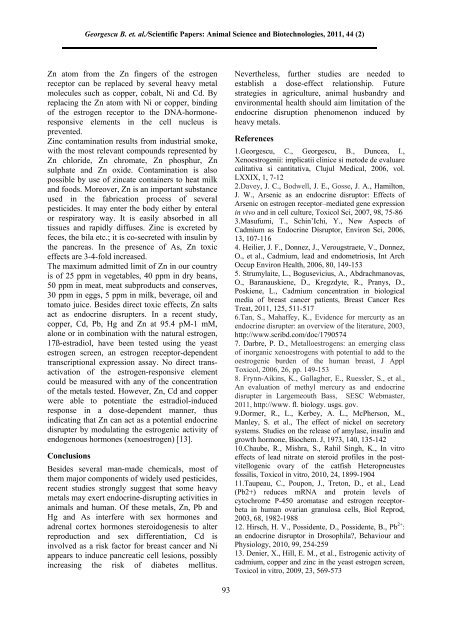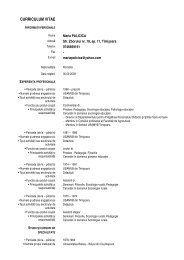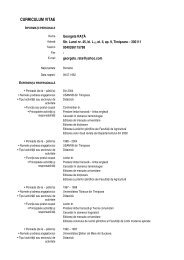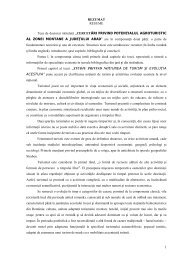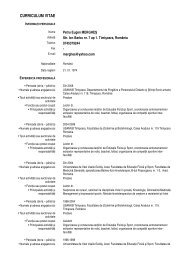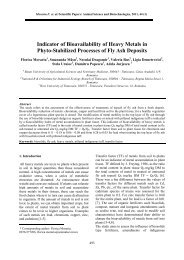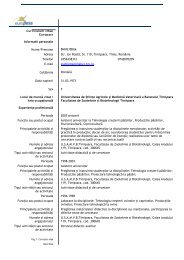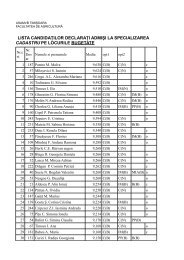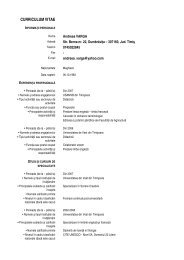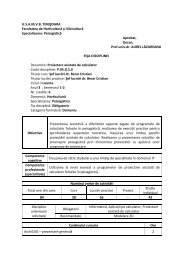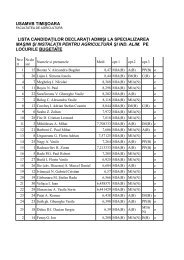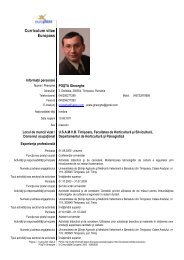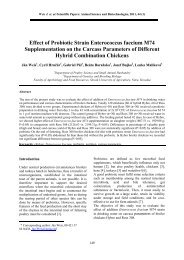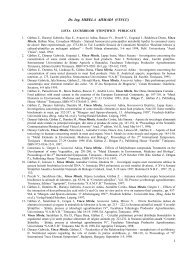Heavy Metals Acting as Endocrine Disrupters
Heavy Metals Acting as Endocrine Disrupters
Heavy Metals Acting as Endocrine Disrupters
You also want an ePaper? Increase the reach of your titles
YUMPU automatically turns print PDFs into web optimized ePapers that Google loves.
Georgescu B. et. al./Scientific Papers: Animal Science and Biotechnologies, 2011, 44 (2)Zn atom from the Zn fingers of the estrogenreceptor can be replaced by several heavy metalmolecules such <strong>as</strong> copper, cobalt, Ni and Cd. Byreplacing the Zn atom with Ni or copper, bindingof the estrogen receptor to the DNA-hormoneresponsiveelements in the cell nucleus isprevented.Zinc contamination results from industrial smoke,with the most relevant compounds represented byZn chloride, Zn chromate, Zn phosphur, Znsulphate and Zn oxide. Contamination is alsopossible by use of zincate containers to heat milkand foods. Moreover, Zn is an important substanceused in the fabrication process of severalpesticides. It may enter the body either by enteralor respiratory way. It is e<strong>as</strong>ily absorbed in alltissues and rapidly diffuses. Zinc is excreted byfeces, the bila etc.; it is co-secreted with insulin bythe pancre<strong>as</strong>. In the presence of As, Zn toxiceffects are 3-4-fold incre<strong>as</strong>ed.The maximum admitted limit of Zn in our countryis of 25 ppm in vegetables, 40 ppm in dry beans,50 ppm in meat, meat subproducts and conserves,30 ppm in eggs, 5 ppm in milk, beverage, oil andtomato juice. Besides direct toxic effects, Zn saltsact <strong>as</strong> endocrine disrupters. In a recent study,copper, Cd, Pb, Hg and Zn at 95.4 pM-1 mM,alone or in combination with the natural estrogen,17ß-estradiol, have been tested using the ye<strong>as</strong>testrogen screen, an estrogen receptor-dependenttranscriptional expression <strong>as</strong>say. No direct transactivationof the estrogen-responsive elementcould be me<strong>as</strong>ured with any of the concentrationof the metals tested. However, Zn, Cd and copperwere able to potentiate the estradiol-inducedresponse in a dose-dependent manner, thusindicating that Zn can act <strong>as</strong> a potential endocrinedisrupter by modulating the estrogenic activity ofendogenous hormones (xenoestrogen) [13].ConclusionsBesides several man-made chemicals, most ofthem major components of widely used pesticides,recent studies strongly suggest that some heavymetals may exert endocrine-disrupting activities inanimals and human. Of these metals, Zn, Pb andHg and As interfere with sex hormones andadrenal cortex hormones steroidogenesis to alterreproduction and sex differentiation, Cd isinvolved <strong>as</strong> a risk factor for bre<strong>as</strong>t cancer and Niappears to induce pancreatic cell lesions, possiblyincre<strong>as</strong>ing the risk of diabetes mellitus.Nevertheless, further studies are needed toestablish a dose-effect relationship. Futurestrategies in agriculture, animal husbandry andenvironmental health should aim limitation of theendocrine disruption phenomenon induced byheavy metals.References1.Georgescu, C., Georgescu, B., Duncea, I.,Xenoestrogenii: implicatii clinice si metode de evaluarecalitativa si cantitativa, Clujul Medical, 2006, vol.LXXIX, 1, 7-122.Davey, J. C., Bodwell, J. E., Gosse, J. A., Hamilton,J. W., Arsenic <strong>as</strong> an endocrine disruptor: Effects ofArsenic on estrogen receptor–mediated gene expressionin vivo and in cell culture, Toxicol Sci, 2007, 98, 75-863.M<strong>as</strong>ufumi, T., Schin’Ichi, Y., New Aspects ofCadmium <strong>as</strong> <strong>Endocrine</strong> Disruptor, Environ Sci, 2006,13, 107-1164. Heilier, J. F., Donnez, J., Verougstraete, V., Donnez,O., et al., Cadmium, lead and endometriosis, Int ArchOccup Environ Health, 2006, 80, 149-1535. Strumylaite, L., Bogusevicius, A., Abdrachmanov<strong>as</strong>,O., Baranauskiene, D., Kregzdyte, R., Pranys, D.,Poskiene, L., Cadmium concentration in biologicalmedia of bre<strong>as</strong>t cancer patients, Bre<strong>as</strong>t Cancer ResTreat, 2011, 125, 511-5176.Tan, S., Mahaffey, K., Evidence for mercurty <strong>as</strong> anendocrine disrupter: an overview of the literature, 2003,http://www.scribd.com/doc/17905747. Darbre, P. D., Metalloestrogens: an emerging cl<strong>as</strong>sof inorganic xenoestrogens with potential to add to theoestrogenic burden of the human bre<strong>as</strong>t, J ApplToxicol, 2006, 26, pp. 149-1538. Frynn-Aikins, K., Gallagher, E., Ruessler, S., et al.,An evaluation of methyl mercury <strong>as</strong> and endocrinedisrupter in Largemeouth B<strong>as</strong>s, SESC Webm<strong>as</strong>ter,2011, http://www. fl. biology. usgs. gov.9.Dormer, R., L., Kerbey, A. L., McPherson, M.,Manley, S. et al., The effect of nickel on secretorysystems. Studies on the rele<strong>as</strong>e of amyl<strong>as</strong>e, insulin andgrowth hormone, Biochem. J, 1973, 140, 135-14210.Chaube, R., Mishra, S., Rahil Singh, K., In vitroeffects of lead nitrate on steroid profiles in the postvitellogenicovary of the catfish Heteropneustesfossilis, Toxicol in vitro, 2010, 24, 1899-190411.Taupeau, C., Poupon, J., Treton, D., et al., Lead(Pb2+) reduces mRNA and protein levels ofcytochrome P-450 aromat<strong>as</strong>e and estrogen receptorbetain human ovarian granulosa cells, Biol Reprod,2003, 68, 1982-198812. Hirsch, H. V., Possidente, D., Possidente, B., Pb 2+ :an endocrine disruptor in Drosophila?, Behaviour andPhysiology, 2010, 99, 254-25913. Denier, X., Hill, E. M., et al., Estrogenic activity ofcadmium, copper and zinc in the ye<strong>as</strong>t estrogen screen,Toxicol in vitro, 2009, 23, 569-57393


